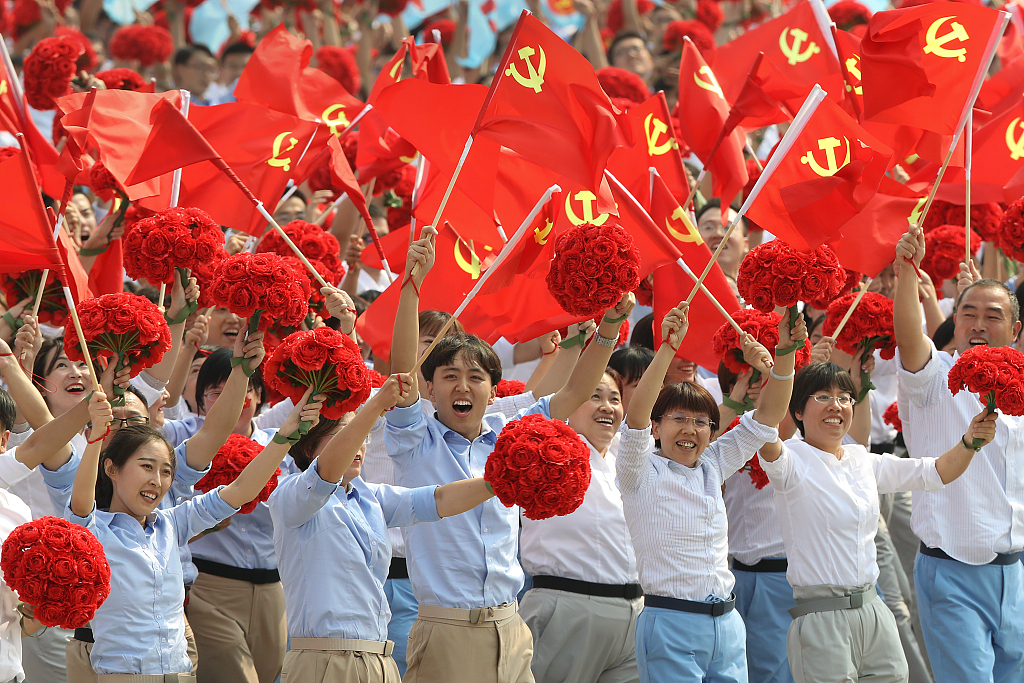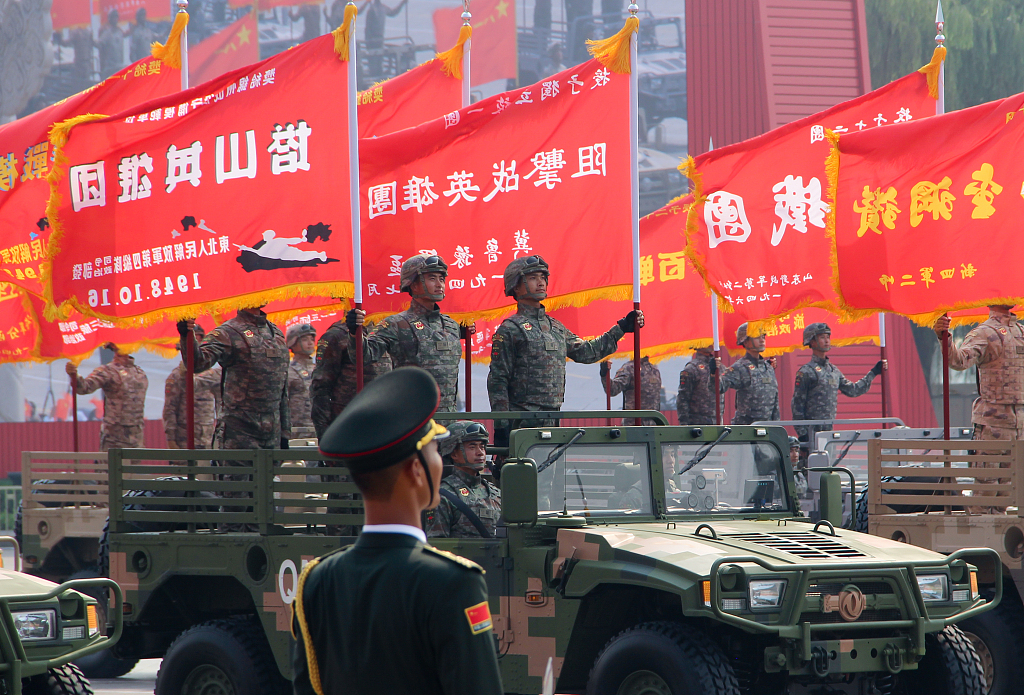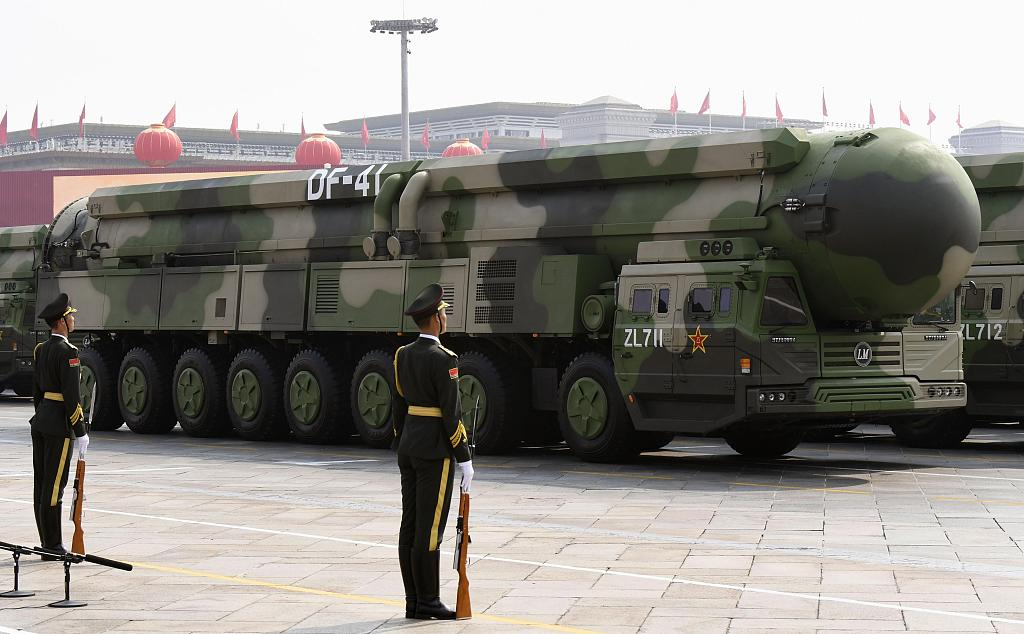Editor's Note: Ma Jun is a Beijing-based military expert. The article reflects the author's opinions, and not necessarily the views of CGTN.
China's National Day is one of the major occasions celebrated by the entire nation. The spectacular military and civilian parade, a grand display of traditional Chinese culture, add further to the festive mood.
For ordinary Chinese, seeing phalanxes of soldiers full of vim and vigor marching in perfect unison gives them a sense of pride and joy. For the Chinese military, showcasing its achievements is not only a tribute to revolutionary martyrs, but also a demonstration of their firm resolve in defending the nation and safeguarding world peace.
This is what some foreign media outlets fail to understand. All they see are pieces of weaponry, and they interpret that as a sign of China's flexing its muscle through the parade.
What did the Chinese military actually intend to show?

People celebrate the National Day at Tian'anmen Square, Beijing, China, October 1, 2019. /VCG Photo
People celebrate the National Day at Tian'anmen Square, Beijing, China, October 1, 2019. /VCG Photo
Continuation of revolutionary spirit
During the parade, an empty car with the plate number "1949" sparked heated discussions online. It's believed to be a gesture to commemorate the revolutionary heroes who laid down their lives for the country.
In addition, among the soldier phalanxes, the "Battle Flag" unit led by commanders of China's five combat zones symbolized Chinese military's historical development and a continuation of the revolutionary spirit.
In other countries, for instance Russia and France, military parades also see soldier phalanxes dressed in World War II-era uniforms and waving battle flags in memory of fallen troops. So, what exactly is the connection between a commemorative act like this and so-called muscle flexing?

"Battle Flag" unit passes through Tian'anmen Square during the military parade in Beijing, China, October 1, 2019. /VCG Photo
"Battle Flag" unit passes through Tian'anmen Square during the military parade in Beijing, China, October 1, 2019. /VCG Photo
Newly-added military components
Moreover, apart from the traditional PLA Army, Navy, Air Force and Rocket Force formations, there were some newly-added components among the marching phalanxes, including support forces, civil service and peacekeepers. These marching blocks represent the new structure after an overhaul of the Chinese military, which cut its troops by 300,000.
A country's army is subject to constant adjustments and reforms based on its national and military needs. This is all too common. For example, the U.S. established the Air Force Space Command and the Cyber Command in accordance to its own military developments.
Among all those that have reorganized their military, why is China singled out and accused of muscle flexing?
Notably, the formation of Chinese peacekeepers demonstrated the resolve of China, now the largest contributor of international peacekeeping forces, to uphold world peace and regional security and stability.
This is in stark contrast to countries that brandish their military might across the world, stirring up trouble in the name of freedom of navigation.

DF-41, a nuclear-capable intercontinental ballistic missile, is on display during the military parade in Beijing, China, October 1, 2019. /VCG Photo
DF-41, a nuclear-capable intercontinental ballistic missile, is on display during the military parade in Beijing, China, October 1, 2019. /VCG Photo
Latest weaponry advance
The warfare equipment unit of the parade, made up of seven modules and 31 formations, was a display of China's latest weaponry development. Apart from the formation of new combat forces, like the information-based armed forces and the unmanned aerial vehicle phalanxes, defense systems including the land-based, field-based and carrier-based air defense weapons were also on display.
In fact, information-based and unmanned weapons are already part of the military arsenal in most countries. The U.S. repeatedly used such weapons in the wars in Afghanistan, Iraq, and Bosnian. China's parade simply showed its adaptability to modern warfare.
The display of advanced weapons such as DF-31, DF-5B, DF-41, H6-N, etc. were major fodders for those trumpeting the "China threat" theory to support the muscle flexing narrative.
Some even say that China is overtaking the U.S. in hypersonic cruise missiles, posing a threat to regional stability. This is an ill-informed and misleading claim made out of ignorance — or feigned ignorance — of China's national defense policy.
China's has been adhering to a defense-oriented approach in national security. The new Defense White Paper stresses that China will never seek hegemony, expansion or spheres of influence. China's national defense strategies are always aimed at meeting its own legitimate security needs and promoting world peace.
China has reiterated its non-first-use principle of nuclear weapons. As an advocate for complete prohibition and thorough destruction of nuclear weapons, China's nuclear strategy is for defensive purposes only. Strategic weaponry is the bedrock of China's national security, but never a coercion against others.
Before hyping up "China threat" theory, Western media outlets should learn more about traditional Chinese culture, as this may help them better understand the relevance of the National Day parade, China's national defense policy and the fact that China is a keeper, not a spoiler, of world peace.
China does not find it necessary to flex its muscles and would never bother to do so.
(If you want to contribute and have specific expertise, please contact us at opinions@cgtn.com.)